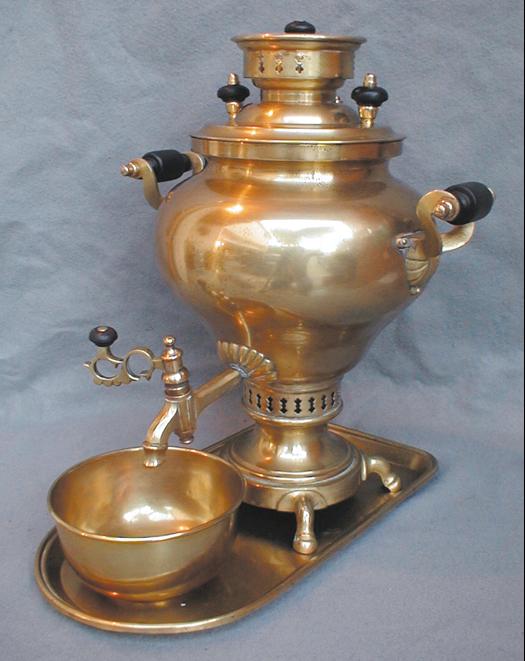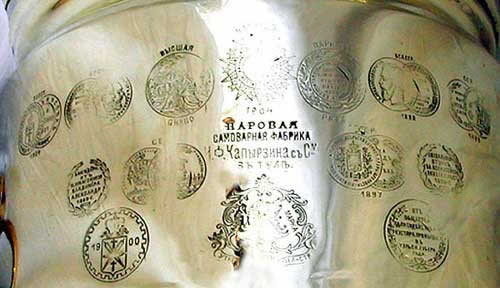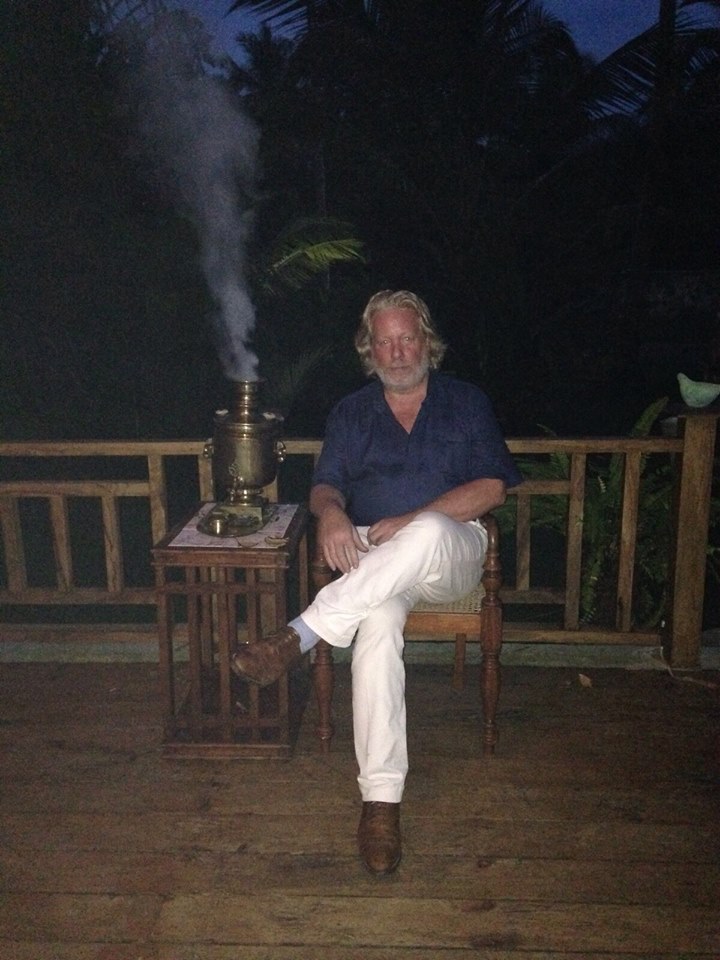 The traditional Russian Samovars are wonderful objects, beautiful in their own right, yet with a specific purpose – brewing water for tea making. The best Samovars were made in Tula, just south of Moscow, with the very best makers displaying stamps that their samovars – all hand made – had won at various international competitions for craftsmanship. Most were made of brass, but it is possible to find samovars made from silver, gold, and even enamel. For obvious reasons, these can be highly valuable, whereas a good quality brass Samovar in working order can still be found for under USD100 on ebay. They are a worthwhile purchase, not because of the increasing scarcity of them -but because they are such fun to use. Imperial era -pre 1917 samovars are the best, and should come complete with matching tray. drip bowl, and a cap. Many also have matching brass teapots that fit neatly on the top.
The traditional Russian Samovars are wonderful objects, beautiful in their own right, yet with a specific purpose – brewing water for tea making. The best Samovars were made in Tula, just south of Moscow, with the very best makers displaying stamps that their samovars – all hand made – had won at various international competitions for craftsmanship. Most were made of brass, but it is possible to find samovars made from silver, gold, and even enamel. For obvious reasons, these can be highly valuable, whereas a good quality brass Samovar in working order can still be found for under USD100 on ebay. They are a worthwhile purchase, not because of the increasing scarcity of them -but because they are such fun to use. Imperial era -pre 1917 samovars are the best, and should come complete with matching tray. drip bowl, and a cap. Many also have matching brass teapots that fit neatly on the top.
 The point about Samovars is that they infuse the water with the essence of the fuel being used. Russians like their tea aromatic, and flavourful, partly because they grew used to the tea arriving on the Silk Road Caravans, often by horse and camel, via a journey taking several months across Central Asia from the teas China origins. Such tea, even today termed “Karavanserai” developed a smoked flavor to it as each evening the Caravans would stop, light a fire, prepare dinner and rest.
The point about Samovars is that they infuse the water with the essence of the fuel being used. Russians like their tea aromatic, and flavourful, partly because they grew used to the tea arriving on the Silk Road Caravans, often by horse and camel, via a journey taking several months across Central Asia from the teas China origins. Such tea, even today termed “Karavanserai” developed a smoked flavor to it as each evening the Caravans would stop, light a fire, prepare dinner and rest.
This means that the fuel used in a samovar is of the utmost importance, although it is possible to experiment. Traditionally, pine cones are used. A small coal or similar fuel briquette is placed, already combusting, at the bottom of the central chimney, which is open at the base via a metal grill. (It is important this is clean and free of obstruction so as to introduce oxygen). The samovar itself should of course be full of water around the central chimney. Place dry pine cones on top, of the briquette, and with a bit of huffing and puffing, they will catch fire. The water will then start to heat. Extra cones may be added as needed until the water is boiling, at which time water can be drawn off, and a tea pot can either be placed on top, or left standing to brew with your favorite blend. The smoke from the pine cones will have added a certain mild taste to the water, which goes very well, and especially so with the Karavanserai blends.

However, its also possible to use other woods as fuel. As I spend part of the year in Sri Lanka, which of course has excellent tea estates as well as being tropical, I’ve been able to use the discarded tea twigs from the pickings, as well as cinnamon twigs, and most successfully, dried coconut husks. All work very well.
Concerning Russian tea, the most famous are the Kusmi Tea blenders, who used to sell tea to the Tsar, but fled Russia during the revolution and are now based in Paris. They still make the old Tsarist era recipes today, with “Prince Vladimir” and the “St. Petersbourg” blends, which are mixed with dried berries, and vanilla and bison grass respectively being my favorites. Meanwhile, the excellent Mariage Freres, also in Paris, is one of the best tea shops in the world and even has its own little café. They provide hundreds of blends – you can even make your own. They offer several outstanding Russian blends, again from yesteryear. The Russians, like all civilized people, drink their tea either neat, or with a slice of lemon.